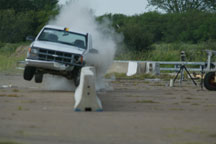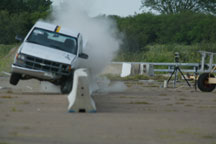Living to tell about it — there’s nothing our researchers take more seriously
Nationally, in 2006, there were 5,973,000 police-reported motor vehicle crashes, which killed a total of 42,642 people — 3,475 right here in Texas.
Here are some sobering national numbers from 2006:
- 13,470 people were killed in alcohol-impaired-driving crashes, nearly 32 percent of all crash-related deaths;
- 61,000 pedestrians were injured in traffic crashes; 4,784 pedestrians were killed — down 12 percent from a decade prior; and
- 4,810 motorcyclists were killed — a 5 percent jump in crash fatalities over 2005.
As startling as these statistics are, the numbers were much more alarming 60 years ago. In fact, thanks to the construction of the interstate highway system, the fatality rate on those roads is 60 percent lower than that of the rest of the roadway system. On the safety-research front, projects sponsored by the Texas Department of Transportation (TxDOT) and conducted at the Texas Transportation Institute (TTI) have produced numerous life-saving discoveries, such as the “breakaway” sign concept and specifications for improved safety of roadside structures. Through performance of countless crash tests over the last 50 years, Texas has led the way to implementation of safer signs, light and utility poles, medians, mailboxes and guardrails all across the nation.
A low-deflection life saver
Every day portable concrete traffic barriers are saving lives. They’re trucked to construction locations and set up quickly, and before long traffic is flowing in temporary lanes. Oncoming cars are kept safely apart and in their lane of travel.
Depending on the segment length used, the low-deflection precast concrete barrier developed and tested at TTI has only 18 to 24 inches of lateral movement during a design impact, putting it in a class by itself. In full-scale crash testing performed at TTI by the Roadside Safety Program, the low-deflection precast barrier proved exceptional at safely shrugging off the impact of a 4,409-pound pickup truck smashing into it at more than 60 miles per hour and 25 degrees. The barrier successfully contained the pickup, redirected it and kept it upright, all necessary criteria when evaluating safety and impact performance.
According to TTI Research Engineer Bligh, the F-shape barrier showed another characteristic that engineers were eager to achieve — when impacted by a vehicle, the barrier didn’t shove aside, or “deflect,” nearly as much as other portable barriers in common use. In fact, use of an innovative cross-bolt connection provides this new barrier with the lowest design deflection of any approved free-standing portable concrete barrier. This finding allowed researchers to recommend the low-deflection precast concrete barrier for use in restricted construction sites, where quarters are cramped and workers run the risk of being hit by a barrier being shoved into the work zone in a collision.
“The new barrier achieves the objective of low dynamic deflection without sacrificing constructability,” says Bligh. “The low deflections associated with the cross-bolt connection make it ideal for use in restricted work zones where it is desirable to minimize the required buffer space between the barrier and the work activity area. TxDOT has implemented the new F-shape barrier as a state standard, and other state departments of transportation are evaluating the barrier as well.”
And the adaptability of the cross-bolt connection to other barrier shapes makes it versatile as well as functional.





